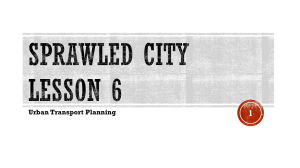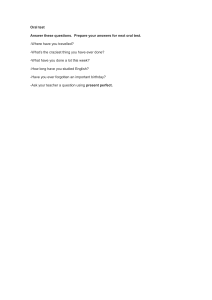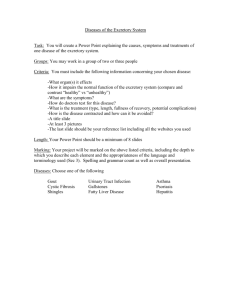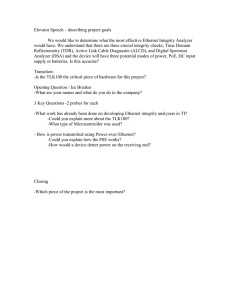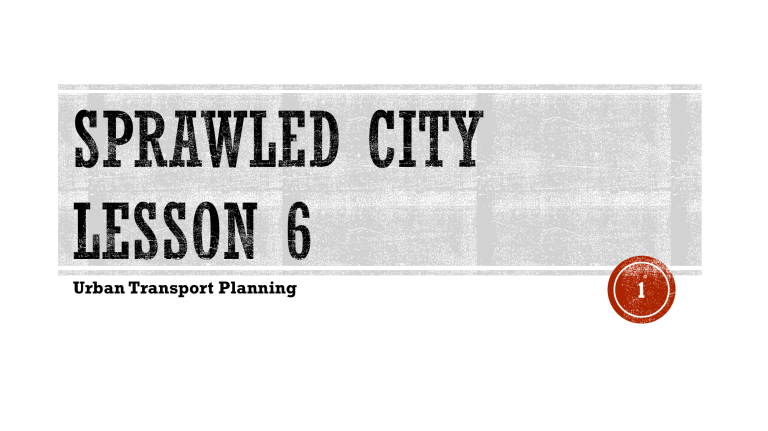
Urban Transport Planning 1 URBAN TRANSPORT PLANNING 2 • • • • • • Approach for transport planning (Traditional v/s contemporary planning) Urban Transport Planning Strategies Preparing Comprehensive Mobility Plans Role of Policies in Urban Transport Planning Concepts of Alternative Analysis Establish Service Level Benchmarks for cities 3 • Transport planning is an exercise of evolving policies and strategies that give a rational direction to activities towards fulfilling a set of goals and objectives in Transport. • Transportation planning is an integral part of overall urban planning and requires a systematic approach. 4 Growing Economy: Road Safety: Increased Car Ownership Increased Traffic Volumes Increased congestion Increased speed Increased conflicts among modes Increased accidents and fatalities 5 Urban Sprawl: More car dependency Increased trip lengths High costs for extending infrastructure and services Energy Consumption Transport consumes 30% of total energy Increased demand for fossil fuel Increased GHG emissions 6 Climate Change: Global warming Higher emission levels Air and noise pollution 7 Urban Transport Planning Approaches 8 Traditional Approach Development of townships far from the city center Homogenous form. Predominantly residential. No mixed use Connected to the city center by broad roads, encourages automobile use Ad-hoc development; no public transport, NMT networks planned 9 Traditional Approach 10 Sustainable Approach Sustainable transport refers to any means of transport with low impact on the environment, and includes walking and cycling, as as well as technology to move people, goods, and information in ways that reduce its impact on the environment, the economy, and society Efficient, Equitable, and Environmentally friendly transport ! 11 • Access: The City should be designed for people, not cars. It should be at least as convenient to live in a city without a personal motor vehicle as with one • Equity: Highest priority should go to public transport, walking, motorized vehicles and non- • Environment: Prevention of air and noise pollution • Economy: Users of cars and motorcycles should be charged for the full economic, environmental, and social costs of their transportation. • Integrated Planning approach within a comprehensive policy framework. • Public participation and transparency: It is important that the public be consulted in planning process 12 SUTP – STRATEGIES AVOID Avoid: Avoiding or reducing trips Shift: Shifting to more environmentally friendly modes Improve: Improving vehicle and fuel technology of all modes of transport to improve environmental efficiency from each kilometer travelled Reducing the need to travel SHIFT Changing mode choice IMPROVE Increasing the energy efficiency of vehicles, fuels, and transport operations 13 Avoid Strategies: Integrated Land use and Transport Mixed Use Development-Transit Oriented Development Information and Communication Technology Shift Strategies: Non-Motorized Transport Public Transport Transportation Demand Management Improve Strategies: Cleaner Fuels and Technologies Inspection and Maintenance Intelligent Transportation System 14 15 URBAN TRANSPORT POLICY 16 • • A policy is a guiding principle used to • State matters of principle set direction • Focused on action, stating what is to be It can be a course of action to guide and influence decisions • • It should be used as a guide to decision making under done and by whom a given set An authoritative statement, made by a person or body with power to do so of circumstances within the framework of objectives, goals and strategies to be These are the features common to good adopted policy 17 • Supply – Network, Public Transport, NMT, Parking, Environment • Demand–Congestion pricing, Parking pricing • Implementation–Institutional, Financing • Operation – Fare Fixation, Licensing 18 • To recognize that people occupy centerstage in our cities and all plans would be for their common benefit and well being • To make our cities the most livable in the world and enable them to become the “engines of economic growth” that power India’s development in the 21st century • To allow our cities to evolve into an urban form that is best suited for the unique geography of their locations and is best placed to support the main social and economic activities that take place in the city. 19 1. 2. 3. 4. 5. 6. 7. Definition -What problem is the plan intended to solve? Projection -How will the situation develop if the problem continues? Constraints -What are the limits of finance, time, etc. within which planning must take place? Option -What are the alternatives and their pros and cons? Formulation -What are the main alternative plans, i.e. packages of available option within the prevailing constraints? Testing -How would each of the alternative plans work out in practice? Evaluation -Which plan gives the greatest value (within the constraints) in terms of solving the problems already defined 20 … now let us identify some GAPS in the existing planning process, before we understand how the process ideally should happen….. 21 Lack of vision and holistic approach Lack of public participation and engagement Weak Coordination between Land use and Transport Gaps Data Challenges – Standards, Collection, Repository Institutional Challenges Inadequate Planning Capacity 22 URBAN TRANSPORT PLANNING 23 • An urban transport planning Vision Financing Institution Alternatives Goals & Objective Strategies Proposals /Projects is a cycle - logical sequence of tasks starting from .. • Vision /Goals / Objectives • Strategies • Proposals • Alternate Analysis • Institutional Framework • Finance 24 • The vision statement is a guiding principle to develop strategies • Adheres to the needs of the population • Transport vision of the city should encompass Vision all elements of a sustainable transport system 25 They provide the concepts of Equity Safety Integrated planning Use of public transport Goals and Objectives Promotion of non-motorized modes Accessibility Travel demand reduction Reliability Clean energy usage Use of technology 26 1. Integrated Land use and transport strategy TOD National Urban Habitat Mission 2. Network Development Strategy 3. Mobility Corridor Strategy 4. Public Transport Strategy Bus augmentation Higher order MRTs Intermodal Integration 5. Non- Motorized Transport Strategy Cycles/cyclists Pedestrians 6. Freight Management Strategy 7. Parking Strategy 8. IPT Strategy 9. Traffic Management 10. Travel Demand Management Strategy 27 28
